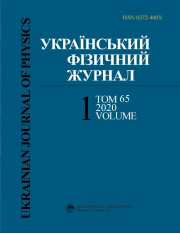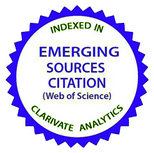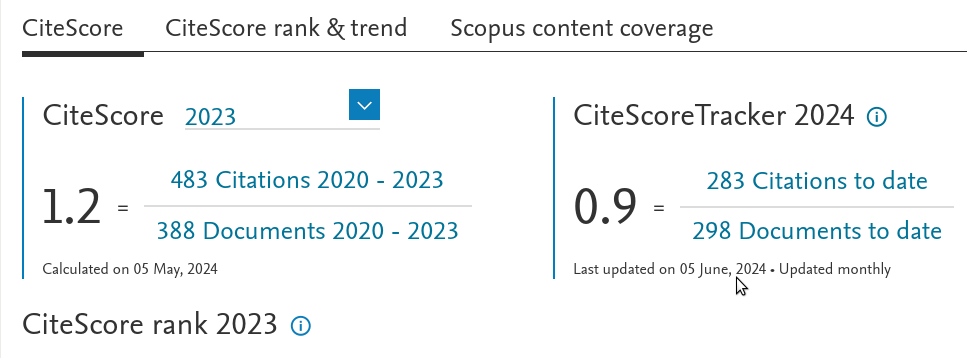Надзвичайні властивості спиртів метанолового ряду
DOI:
https://doi.org/10.15407/ujpe65.1.31Ключові слова:
одноатомнi первиннi спирти, густина, оптичнi та дiелектричнi властивостiАнотація
Аналiзуються нетривiальнi характеристики термодинамiчних величин первинних спиртiв метанолового гомологiчного ряду, в першу чергу, їх густин, температур критичної та потрiйної точок, а також їх вiдношення та оптичнi i дiелектричнi поляризовностi. Дослiджується характер взаємного зв’язку мiж ними за однакових температур для спиртiв з рiзними порядковими номерами m в ряду метанолу. Показано, що немонотонний характер температурної залежностi густини спиртiв обумовлений не етанолом, як здається на перший погляд, а метанолом. Критична температура останнього випадає з квазiлiнiйної залежностi значень критичних температур спиртiв вiд m. Показано, що вiдношення критичної температури спиртiв до температури їх потрiйної точки зi зростанням m асимптотично прямує до вiдповiдного вiдношення для води. Встановлено простi лiнiйнi залежностi вiд m електронної та ефективної статичної поляризовностей спиртiв. Знайдено поперечну та поздовжню складовi тензора поляризовностi молекул спиртiв. Доведено, що дипольнi моменти найближчих сусiдiв в спиртах антикорелюють, тобто намагаються встановлюватись у протилежних напрямках.
Посилання
P. Golub, I. Doroshenko, V. Pogorelov. Quantum-chemical modeling of energy parameters and vibrational spectra of chain and cyclic clusters of monohydric alcohols. Phys. Lett. A 378, 1937 (2014). https://doi.org/10.1016/j.physleta.2014.04.032
V.N. Stabnikov, I.M. Roiter, T.B. Protsyuk. Ethyl Alcohol (Pishchevaya Promyshlennost, 1976) (in Russian).
A Brief Handbook of Physicochemical Values. Edited by A.A. Ravdel', A.M. Ponomareva (Spetsialnaya Literatura, 1998) (in Russian).
Chemist's Handbook, Vol. 1 (Khimiya, 1982) (in Russian).
Tables of Physical Quantities. Edited by I.K. Kikoin. (Atomizdat, 1976) (in Russian).
M.M. Karavaev, V.E. Leonov, I.G. Popov, E.T. Shepelev. Technology of Synthetic Methanol (Khimiya, 1984) (in Russian).
V. Pogorelov, L. Bulavin, I. Doroshenko, O. Fesjun, O. Veretennikov. The structure of liquid alcohols and the temperature dependence of vibrational bandwidth. J. Mol. Struct. 708, 61 (2004). https://doi.org/10.1016/j.molstruc.2004.03.003
V. Pogorelov, A. Yevglevsky, I. Doroshenko, L. Berezovchuk, Yu. Zhovtobryuch. Nanoscale molecular clusters and vibrational relaxation in simple alcohols. Superlat. Microstruct. 44, 571 (2008). https://doi.org/10.1016/j.spmi.2008.01.014
T.V. Lokotosh, N.P. Malomuzh, V.L. Zakharchenko. Anomalous density and permittivity effects on the structure of water. J. Struct. Chem. 44, 1001 (2003). https://doi.org/10.1023/B:JORY.0000034807.32927.58
N.P. Malomuzh, A.V. Oleinik. Nature of the kinematic shear viscosity of water. J. Struct. Chem. 49, 1055 (2008). https://doi.org/10.1007/s10947-008-0178-1
A.I. Fisenko, N.P. Malomuzh, A.V. Oleynik. To what extent are thermodynamic properties of water argon-like? Chem. Phys. Lett. 450, 297 (2008). https://doi.org/10.1016/j.cplett.2007.11.036
M. Born, E. Wolf. Principles of Optics (Cambridge Univ. Press, 1999).
V.Ya. Gotsul'skii, N.P. Malomuzh, V.E. Chechko. Properties of hydrogen bonds in water and monohydric alcohols. Russ. J. Phys. Chem. A 92, 1516 (2018). https://doi.org/10.1134/S0036024418080149
V.E. Chechko, V.Ya. Gotsulsky, N.P. Malomuzh. Surprising thermodynamic properties of alcohols and water on their coexistence curves. J. Mol. Liq. 272, 590 (2018). https://doi.org/10.1016/j.molliq.2018.09.126
V.Ya. Gotsul'skii, N.P. Malomuzh, V.E. Chechko. The role of two-particle effects in the behavior of refraction of single-component liquids and two-component solutions. Opt. Spectrosc. 120, 615 (2016). https://doi.org/10.1134/S0030400X16030103
D.S. Eisenberg, W. Kauzmann. The Structure and Properties of Water (Oxford Univ. Press, 2005) (ISBN: 0198570260, 9780198570264). https://doi.org/10.1093/acprof:oso/9780198570264.001.0001
D.W. Davidson. The dielectric properties of methanol and methanol-d. Can. J. Chem. 35, 458 (1957). https://doi.org/10.1139/v57-066
R.M. Shirke, A. Chaudhari, N.M. More, P.B. Patil. Dielectric measurements on methyl acetate + alcohol mixtures at (288, 298, 308, and 318) K using the time domain technique. J. Chem. Eng. Data 45, 917 (2000). https://doi.org/10.1021/je000066+
R.M. Shirke, A. Chaudhari, N.M. More, P.B. Patil. Temperature dependent dielectric relaxation study of ethyl acetate - alcohol mixtures using time domain technique. J. Mol. Liq. 94, 27 (2001). https://doi.org/10.1016/S0167-7322(01)00239-2
M.T. Khimenko, V.V. Aleksandrov, N.N. Gritsenko. Polarizability and radii of molecules of some pure liquids. Zh. Fiz. Khim. 47, 2914 (1973) (in Russian).
V.A. Granzhan, O.G. Kirillova. Physico-chemical study of N-methyl-2-pyrrolidone-methanol system. Zh. Prikl. Khim. 43, 1875 (1970) (in Russian).
F.X. Hasslon, R.H. Cole. Dielectric properties of liquid ethanol and 2-propanol. J. Chem. Phys. 23, 1756 (1955). https://doi.org/10.1063/1.1740575
V.N. Makhlaichuk, N.P. Malomuzh. Manifestation of cluster excitations in dielectric properties of water vapor and liquid water as well as their heat capacity. J. Mol. Liq. 253, 83 (2018). https://doi.org/10.1016/j.molliq.2018.01.018
N.P. Malomuzh, V.M. Makhlaichuk. Dimerization degree of water molecules, their effective polarizability, and heat capacity of saturated water vapor. Ukr. J. Phys. 63, 121 (2018). https://doi.org/10.15407/ujpe63.2.121
J.G. Kirkwood. Theory of solutions of molecules containing widely separated charges with special application to zwitterions. J. Chem. Phys. 2, 351 (1934). https://doi.org/10.1063/1.1749489
I.E. Tamm. Fundamentals of the Theory of Electricity (Mir, 1979).
O.A. Osipov, V.I. Minkin, A.D. Garnovskii. Handbook on Dipole Moments (Vysshaya Shkola, 1971) (in Russian).
P. Venkateswarlu, W. Gordy. Methyl alcohol II. Molecular structure. J. Chem. Phys. 23, 1200 (1955). https://doi.org/10.1063/1.1742240
L.D. Landau, E.M. Lifshitz. Statistical Physics (Butterworth-Heinemann, 1980) [ISBN: 978-0-7506-3372-7].
M. Gude, A.S. Teja. Vapor-liquid critical properties of elements and compounds. 4. Aliphatic alkanols. J. Chem. Eng. Data 40, 1025 (1995). https://doi.org/10.1021/je00021a001
R.C. Wilhoit, J.Chao, K.R. Hall. Thermodynamic properties of key organic compounds in the carbon range C1 to C4. Part 1. Properties of condensed phases. J. Phys. Chem. Ref. Data 14, 1 (1985). https://doi.org/10.1063/1.555747
J.F. Counsell, J.L. Hales, J.F. Martin. Thermodynamic properties of organic oxygen compounds. Part 16. Butyl alcohol. Trans. Faraday Soc. 61, 1869 (1965). https://doi.org/10.1039/TF9656101869
G.S. Parks, H.M. Huffman, M. Barmore. Thermal data on organic compounds. XI. The heat capacities, entropies and free energies of ten compounds containing oxygen or nitrogen. J. Am. Chem. Soc. 55, 7, 2733 (1933). https://doi.org/10.1021/ja01334a016
K.K. Kelley. The heat capacities of ethyl and hexyl alcohols from 16 to 298 K and the corresponding entropies and free energies. J. Am. Chem. Soc. 51, 779 (1929). https://doi.org/10.1021/ja01378a016
G.S. Parks, W.D. Kennedy, R.R. Gates, J.R. Mosley, G.E. Moore, M.L. Renquist. Thermal data on organic compounds XXVI. Some heat capacity, entropy and free energy data for seven compounds containing oxygen. J. Am. Chem. Soc. 78, 56 (1956). https://doi.org/10.1021/ja01582a015
C. Spizzichino. Contribution a l'etude des tensions de vapeur et des chaleurs de vaporisation des acides gras, esters methyliques et alcools gras a des pressions inferieures a 1 mm de mercure. J. Recherch. CNRS 34, 1 (1956).
Downloads
Опубліковано
Як цитувати
Номер
Розділ
Ліцензія
Ліцензійний Договір
на використання Твору
м. Київ, Україна
Відповідальний автор та співавтори (надалі іменовані як Автор(и)) статті, яку він (вони) подають до Українського фізичного журналу, (надалі іменована як Твір) з одного боку та Інститут теоретичної фізики імені М.М. Боголюбова НАН України в особі директора (надалі – Видавець) з іншого боку уклали даний Договір про таке:
1. Предмет договору.
Автор(и) надає(ють) Видавцю безоплатно невиключні права на використання Твору (наукового, технічного або іншого характеру) на умовах, визначених цим Договором.
2. Способи використання Твору.
2.1. Автор(и) надає(ють) Видавцю право на використання Твору таким чином:
2.1.1. Використовувати Твір шляхом його видання в Українському фізичному журналі (далі – Видання) мовою оригіналу та в перекладі на англійську (погоджений Автором(ами) і Видавцем примірник Твору, прийнятого до друку, є невід’ємною частиною Ліцензійного договору).
2.1.2. Переробляти, адаптувати або іншим чином змінювати Твір за погодженням з Автором(ами).
2.1.3. Перекладати Твір у випадку, коли Твір викладений іншою мовою, ніж мова, якою передбачена публікація у Виданні.
2.2. Якщо Автор(и) виявить(лять) бажання використовувати Твір в інший спосіб, як то публікувати перекладену версію Твору (окрім випадку, зазначеного в п. 2.1.3 цього Договору); розміщувати повністю або частково в мережі Інтернет; публікувати Твір в інших, у тому числі іноземних, виданнях; включати Твір як складову частину інших збірників, антологій, енциклопедій тощо, то Автор(и) мають отримати на це письмовий дозвіл від Видавця.
3. Територія використання.
Автор(и) надає(ють) Видавцю право на використання Твору способами, зазначеними у п.п. 2.1.1–2.1.3 цього Договору, на території України, а також право на розповсюдження Твору як невід’ємної складової частини Видання на території України та інших країн шляхом передплати, продажу та безоплатної передачі третій стороні.
4. Строк, на який надаються права.
4.1. Договір є чинним з дати підписання та діє протягом усього часу функціонування Видання.
5. Застереження.
5.1. Автор(и) заявляє(ють), що:
– він/вона є автором (співавтором) Твору;
– авторські права на даний Твір не передані іншій стороні;
– даний Твір не був раніше опублікований і не буде опублікований у будь-якому іншому виданні до публікації його Видавцем (див. також п. 2.2);
– Автор(и) не порушив(ли) права інтелектуальної власності інших осіб. Якщо у Творі наведені матеріали інших осіб за виключенням випадків цитування в обсязі, виправданому науковим, інформаційним або критичним характером Твору, використання таких матеріалів здійснене Автором(ами) з дотриманням норм міжнародного законодавства і законодавства України.
6. Реквізити і підписи сторін.
Видавець: Інститут теоретичної фізики імені М.М. Боголюбова НАН України.
Адреса: м. Київ, вул. Метрологічна 14-б.
Автор: Електронний підпис від імені та за погодження всіх співавторів.

















